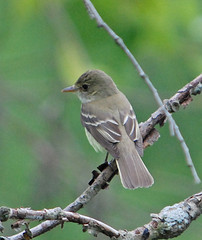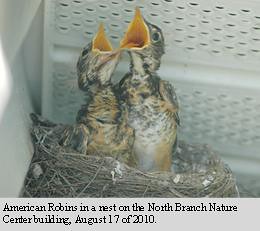Monday, December 19, 2011
51st Plainfield Christmas Bird Count
“Atypical” would be a good word to describe the 51st Plainfield Christmas Bird Count. Warm temperatures leading up to the count and the absence of snow likely played a role in the birds we encountered. While the number of species seen (37) was higher than average, the total number of individuals was rather low. Many of the “common” birds were sparse, and extremely low counts were reported for many species including chickadees, nuthatches, blue jays, and woodpeckers. With an abundance of open ground and hence plenty of foraging area for birds, it is possible that the usual year-round residents were dispersed across a larger area than normal, rather than being concentrated at feeders.
While most birds were hard to find, some appeared in record numbers. New high counts were set for American Robin and Canada Goose, both of which have likely been taking advantage of the mild weather. Other lingering birds included a White-throated Sparrow and a Red-winged Blackbird, both found visiting feeders during the count day. An immature Herring Gull, the first on the count in 12-years, was also probably taking advantage of the unusually large amount of open water in the count circle.
The crown jewel of this year’s CBC had to be a Golden Eagle observed near Marshfield Mountain. Not only are Golden Eagles rare year-round, they are especially rare outside of fall migration, which typically tapers off in mid-November. This was the first Golden Eagle on the count in its 50-year history.
Preliminary results of the Plainfield CBC are shown below:
Canada Goose 830
Mallard 6
Hooded Merganser 3
Common Merganser 2
Ruffed Grouse 5
Wild Turkey 83
Bald Eagle 1
Red-tailed Hawk cw
Herring Gull 1
Rock Pigeon 77
Mourning Dove 44
Downy Woodpecker 20
Hairy Woodpecker 25
Pileated Woodpecker 2
Blue Jay 54
American Crow 175
Common Raven 14
Black-capped Chickadee 481
Tufted Titmouse 9
Red-breasted Nuthatch 25
White-breasted Nuthatch 23
Brown Creeper 5
Golden-crowned Kinglet 7
American Robin 27
European Starling 207
Cedar Waxwing 32
American Tree Sparrow 17
White-throated Sparrow 1
Dark-eyed Junco 35
Northern Cardinal 9
Red-winged Blackbird 1
Purple Finch 13
House Finch 14
Pine Siskin 61
American Goldfinch 266
Evening Grosbeak 18
House Sparrow 6
Tuesday, December 13, 2011
Vermont Christmas Bird Counts
Birdwatchers across the western hemisphere are filling their feeders and dusting off their binoculars for the 112th annual Christmas Bird Count (CBC). In Vermont, over a dozen counts will take place, with volunteers spreading out across the pre-determined study-area in an effort to census the winter bird population, leaving no chickadee uncounted. Some counts have taken place for decades, allowing scientists to learn how bird populations are changing over time. In fact, the large, long-term dataset created by the CBC is now used by the EPA as one of their major indicators of global climate change.
Last year, over 60,000 people took aprt in 2,160 counts across 31 countries/territories, setting records. The success of the CBC is due in a large part to the masses of volunteers who count birds for the sake of fun, science, and tradition. Most counts conclude with a potluck dinner, with rarities seen throughout the day being kept secret until everyone is gathered together, so they can be properly boasted. Most counts also welcome new participants, so if you’ve never taken part before, make this holiday season your first and come count some birds!
More info about the Christmas Bird Count
2011/12 VERMONT COUNTS:
Barnet
Jan. 1
Contact: Charlie Brown
cbrowne@fairbanksmuseum.org
Bennington
Dec. 28
Contact: Bonnie Dundas
kinglet@sover.net
Brattleboro
Dec. 17
Contact: Al Merritt
chpmnkx@sover.net
Burlington
Dec. 18
Contact: Shirley Johnson
rjsj489@comcast.net
Compiler: Eric Lazarus
ericlazarus@myfairpoint.net
Champlain Islands/St. Albans
Dec. 18
Contact: Liz Alton
redbnuthatch@gmail.com
Ferrisburgh
Dec. 17
Contact: Mike Winslow
mikekira@myfairpoint.net
Hanover-Norwich
Jan. 1
Contact: Daniel Crook
daniel.crook@hitchcock.org
Hinesburg-Huntington
Dec. 31
Contact: Paul Wieczoreck
mgcpw@gmavt.net
Island Pond
Dec. 15
Contact: Jayson Benoit
jayson@northwoodscenter.org
Mad River Valley/Northfield
Dec. 16
Contact Pat Folsom
pfols@gmavt.net
Middlebury
Dec. 18
Contact: Jim Andrews
jandrews@middlebury.edu
Mt. Abraham
Dec. 17
Contact: Randy Durand
durand@gmavt.net
Plainfield
Dec. 17
Contact: Chip Darmstadt
chip@NorthBranchNatureCenter.org
Randolph Area
Dec. 17
Contact: Rick Enser
rickenser@yahoo.com
Rutland
Dec. 31
Contact: Roy Pilcher
shamwariVT@aol.com
Saxton's River
Dec. 17
Contact: Don Clark
sapsbks@sover.net
Springfield
Dec. 18
Contact: Hugh Putnam
putnams@vermontel.net
Winhall/Windham
Dec. 17
Contact: Ruth Stewart
birder_rws@hotmail.com
Woodstock
Dec. 28
Contact: Sally Laughlin
laughlin@sover.net
Monday, December 12, 2011
Antique Bird Names
Ever see a flock of snowflakes fluttering above a snowy field? How about bullbats cruising over dimly-lit city streets? Or, have you ever seen a sparrow hawk perched patiently on a telephone line? Even sharp birders may not recognize some of these as archaic bird names. All languages evolve over time, but it seems that that bird nomenclature has a relatively short half-life. Bird names change for many reasons, but here are a few of our favorite archaic bird names:
Snowflake – It isn’t too far of a stretch to picture a flock of Snow Buntings over a snowy field and think “snowflakes”. In fact, at the turn of the century this is how Snow Buntings were referred to. When I was first reading through results of the 1906 Christmas Bird Count, I thought the reference to “about a dozen” snowflakes as some kind of old-fashioned birding joke, but in fact, this was an accurate report, given the lingo of the time.
Traill’s Flycatcher – Some of the more exciting name-changing events for birders are when species are split, and one name becomes two. Named after Thomas Stewart Traill, a Scottish professor of medical jurisprudence and promoter of zoology and natural history in the early 1800’s, this nondescript gray-and-white bird became two in 1973. Now known as either Willow or Alder Flycathers, the two species are nearly indistinguishable by sight, but have different songs and habitat preferences. Sometimes, when birders see one of the pair but don’t hear their song, a bird will still be given the ambiguous label of “Traill’s”.
Sparrow Hawk – … is neither a sparrow nor a hawk, so some explanation is warranted! This out-of-date term was used to refer to the American Kestrel, who’s diminutive size derived the “sparrow” part of its name. But the “hawk” part just didn’t fit, as kestrels are a type of falcon, not hawk, and so the name was officially changed in 1973. Many raptors names have similar delineation, and terms such as Fish Hawk, Pigeon Hawk, Marsh Hawk, Duck Hawk, and others still surface from time to time.
Bullbat – Birds that spend much of their lives near people tend to collect a plethora of pseudonyms, and so it is not surprising that a bird that nests on rooftops would be given a nickname. Even the official name “Common Nighthawk” is a bit of a misnomer, as these birds are neither hawks nor are they strictly nocturnal. Others may know the Common Nighthawk better as a “bullbat”, which is a more fitting term. The birds are erratic and bat-like in flight, and cruise over city streets at dusk, feeding on insects. But anyone who has seen a Nighthawk display during the breeding season knows why they call them "bull". Nighthawks will dive bomb other creatures that wander too close, including people, complimenting their bat-like flight with the attitude of a bull.
Snowflake – It isn’t too far of a stretch to picture a flock of Snow Buntings over a snowy field and think “snowflakes”. In fact, at the turn of the century this is how Snow Buntings were referred to. When I was first reading through results of the 1906 Christmas Bird Count, I thought the reference to “about a dozen” snowflakes as some kind of old-fashioned birding joke, but in fact, this was an accurate report, given the lingo of the time.
Traill’s Flycatcher – Some of the more exciting name-changing events for birders are when species are split, and one name becomes two. Named after Thomas Stewart Traill, a Scottish professor of medical jurisprudence and promoter of zoology and natural history in the early 1800’s, this nondescript gray-and-white bird became two in 1973. Now known as either Willow or Alder Flycathers, the two species are nearly indistinguishable by sight, but have different songs and habitat preferences. Sometimes, when birders see one of the pair but don’t hear their song, a bird will still be given the ambiguous label of “Traill’s”.
Sparrow Hawk – … is neither a sparrow nor a hawk, so some explanation is warranted! This out-of-date term was used to refer to the American Kestrel, who’s diminutive size derived the “sparrow” part of its name. But the “hawk” part just didn’t fit, as kestrels are a type of falcon, not hawk, and so the name was officially changed in 1973. Many raptors names have similar delineation, and terms such as Fish Hawk, Pigeon Hawk, Marsh Hawk, Duck Hawk, and others still surface from time to time.
Bullbat – Birds that spend much of their lives near people tend to collect a plethora of pseudonyms, and so it is not surprising that a bird that nests on rooftops would be given a nickname. Even the official name “Common Nighthawk” is a bit of a misnomer, as these birds are neither hawks nor are they strictly nocturnal. Others may know the Common Nighthawk better as a “bullbat”, which is a more fitting term. The birds are erratic and bat-like in flight, and cruise over city streets at dusk, feeding on insects. But anyone who has seen a Nighthawk display during the breeding season knows why they call them "bull". Nighthawks will dive bomb other creatures that wander too close, including people, complimenting their bat-like flight with the attitude of a bull.
What are your favorite Antique Bird Names?
Monday, November 21, 2011
Rare Hummingbird Visits Vermont
 By mid-November, most of the hummingbird feeders in Vermont have been taken down for the season (or the sugar-water has frozen solid), but a feeder in East Arlington, VT continues to be visited by a very cold, very lost hummer!
By mid-November, most of the hummingbird feeders in Vermont have been taken down for the season (or the sugar-water has frozen solid), but a feeder in East Arlington, VT continues to be visited by a very cold, very lost hummer!On November 19, Randy Schmidt of the The Vermont Bird Place & Sky Watch, in
Manchester Center, received a call from a concerned customer who's "Ruby-throated Hummingbird" hadn't yet flown south. As word of this unusual sighting spread throughout the birding community, many began to wonder whether this could be a rare, vagrant hummingbird species. By mid-September, most Ruby-throated Hummingbirds have vacated Vermont for warmer climes, but during this fall/winter period, other species infrequently stray far from their wintering grounds and end up in very unusual places. When they do, they will often find a lingering feeder which they will stake out as their own.
This appears to be what happened in East Arlington, where the vagrant hummingbird has apparently been residing for weeks. It is believed to be of the genus Selasphorus, although a trained hummingbird bander will be visiting tomorrow to more thoroughly document this individual and identify its species. Needless to say, Vermont birders are very excited to have such an unusual avian visitor in our state, and will be anxiously following developments on this sighting.
Monday, November 14, 2011
When Birds Share the Feeder
Anyone who has ever fed birds has likely provided food to a host of other types of creatures. An uninvited squirrel can empty a bird feeder quickly and scare away its intended avian visitors. If only we could just hang a bright, shiny sign on our feeders that says "BIRDS ONLY"...
Of course, different people have different attitudes towards bird feeding and while some recoil when a squirrel partakes in the feeding, others welcome critters of both feather and fur. After all, finding food in winter is difficult for all animals, not just birds. And despite our greatest efforts to deter them,nothing seems to stop determined animals from getting the seed they want.
Here in Vermont, we need to be especially vigilant, as bears can be both a nuisance and a potential threat to safety and property. In areas where bears are present, feeders should not be hung until prolonged cold has sent the bears into hibernation. Other unwelcome visitors, like hawks, will readily prey on the very birds you are trying to help.
What different non-avian creatures have visited your feeder? And how do you feel about feeding creatures of all shapes and sizes?
Monday, October 31, 2011
An eBird Milestone for NBNC
 In addition to costumes and candy, there is other cause for celebration this Halloween. The North Branch Nature Center now has data in eBird for all 52 week-periods of the year! eBird is a massive online bird sightings database, and the missing info from the third week in October was a gap as obvious as a missing front tooth, which has now been filled. Beyond personal interest, eBird has tons of practical implications for avian conservation, allowing scientists to use observations from thousands of bird watchers to study bird distribution and abundance.
In addition to costumes and candy, there is other cause for celebration this Halloween. The North Branch Nature Center now has data in eBird for all 52 week-periods of the year! eBird is a massive online bird sightings database, and the missing info from the third week in October was a gap as obvious as a missing front tooth, which has now been filled. Beyond personal interest, eBird has tons of practical implications for avian conservation, allowing scientists to use observations from thousands of bird watchers to study bird distribution and abundance.While in reality this is not a major milestone, it represents an increased effort by bird watchers everywhere to record what they see and share those observations with scientists and the general public. The current year (2011) marked a particularly deliberate uptick in eBird activity. The Vermont County Quest enlisted birdwatchers from throughout the state in a competition to see which county had “the most birds”, using eBird as a platform for measuring success. The results have been self-evident. Here in Washington County, eBird users have submitted 1642 checklists, a 58% increase from last year at this time.
As an example of the tremendous power of eBird, check out the links below, and the animation of the annual Chestnut-sided Warbler migration, generated using advanced computer models and eBird data:
Vermont eBird homepage
eBird tutorial
eBird bar chart for the North Branch Nature Center
eBird bar chart for all of Washington County, VT
Washington County Birding Challenge

Click here for more info and an interpretation of this computer-generated animation based on eBird data.
Thursday, October 13, 2011
Discovering Rarity
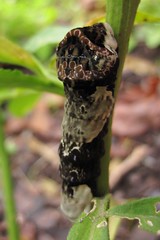 Last week’s blog post featured the second Vermont record for caterpillars of the Giant Swallowtail caterpillars, and the northernmost sighting of this species in the state. Abby Colihan found them while working in the garden in her backyard. But how did Abby ever know to think they might be rare? How many rarities like this are overlooked? And how might you, too, discover a rare critter in your own backyard?
Last week’s blog post featured the second Vermont record for caterpillars of the Giant Swallowtail caterpillars, and the northernmost sighting of this species in the state. Abby Colihan found them while working in the garden in her backyard. But how did Abby ever know to think they might be rare? How many rarities like this are overlooked? And how might you, too, discover a rare critter in your own backyard?Whether it be bird, butterfly, or anything else, a few simple tricks can help reduce the chances that some scarce critter wanders across your gaze undetected.
1) Get outside and look! Pay attention to what’s around you. The more you are out observing nature, the better a feel you will get for what is common and what is not. It doesn’t take studying the names of critters to recognize them… or to recognize that they are unfamiliar.
2) Expect the unexpected. Rare creatures show up every year in Vermont, and chances are, most go unnoticed. David Sibley has blogged about this phenomenon, and has even put a percentage to the rare birds that go unseen. You can’t find what you’re not looking for!
3) Document what you see. If something looks unfamiliar, take a picture! Digital photography has revolutionized the way we can record the natural world, and as a result, many more rare critters are being not only seen, but confirmed.
4) Share your observation! So many times, a rare bird is discovered to the delight of some ecstatic birder, only for them to hear from a neighbor that “it’s been there for weeks!” Call or stop by your local Nature Center, seek out an email list or discussion forum, or swing by your local extension office. You’re likely to find plenty of amateur and professional naturalists who are happy to help you identify your discovery.
The above steps will certainly not guarantee that you find a rare critter. Most people don’t (that’s what makes them rare). But, chances are, when a vagrant bird shows up at your feeder, you'll be more likely to take note. So get outside, observe the wild things around you, pay attention, and you just might discover the next Giant Swallowtail.
As a final primer for your search for rarity, enjoy the following awareness test:
Tuesday, October 4, 2011
A “Giant” Backyard Discovery
It was a day just like any other. Except that when Abby Colihan glanced out the window of her home into her garden, she noticed something different. It looked like a very large pile of bird guano, but upon closer inspection, Abby discovered it to be a caterpillar like none she had ever seen before.

The caterpillar was that of a Giant Swallowtail, a species that before July 30, 2010 had never before been seen in Vermont! This distinctive butterfly is similar in size to our Tiger Swallowtail butterfly with a striking mixture of black and yellow, with dashes of blue and red. Larvae feed on plants in the citrus family (Rutaceae) and resemble bird droppings from above (see picture above). Get up close to one, and it will try to fool you into thinking it is a snake (see picture below). If you still dare mess with this caterpillar, it will reveal its large antennae-like osmeterium that can give off harsh-smelling chemicals.
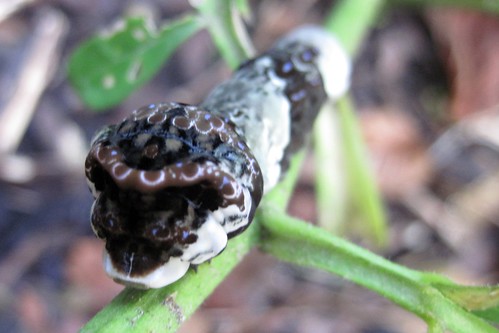
For some time it was suspected that Giant Swallowtail may arrive in Vermont. This species is known to move north some summers, establishing itself where it finds suitable food plants. In 2008, butterfly expert Bryan Pfeiffer noted that the Giant Swallowtail had been seen near Lake George in late August... it was already on its way. This Montpelier record constitutes only the second documentation of larvae in Vermont, and the farthest north this species has been documented in the state. So why didn’t anybody see this Giant Swallowtail before it laid eggs in Abby’s garden as it flew down the streets of Montpelier? And how did Abby know these caterpillars were special?
Stay tuned to our next blog update to learn how you too can discover a rare creature in your own backyard.


The caterpillar was that of a Giant Swallowtail, a species that before July 30, 2010 had never before been seen in Vermont! This distinctive butterfly is similar in size to our Tiger Swallowtail butterfly with a striking mixture of black and yellow, with dashes of blue and red. Larvae feed on plants in the citrus family (Rutaceae) and resemble bird droppings from above (see picture above). Get up close to one, and it will try to fool you into thinking it is a snake (see picture below). If you still dare mess with this caterpillar, it will reveal its large antennae-like osmeterium that can give off harsh-smelling chemicals.

For some time it was suspected that Giant Swallowtail may arrive in Vermont. This species is known to move north some summers, establishing itself where it finds suitable food plants. In 2008, butterfly expert Bryan Pfeiffer noted that the Giant Swallowtail had been seen near Lake George in late August... it was already on its way. This Montpelier record constitutes only the second documentation of larvae in Vermont, and the farthest north this species has been documented in the state. So why didn’t anybody see this Giant Swallowtail before it laid eggs in Abby’s garden as it flew down the streets of Montpelier? And how did Abby know these caterpillars were special?
Stay tuned to our next blog update to learn how you too can discover a rare creature in your own backyard.

Thursday, September 22, 2011
The rare "Buckeye" Flutters at NBNC
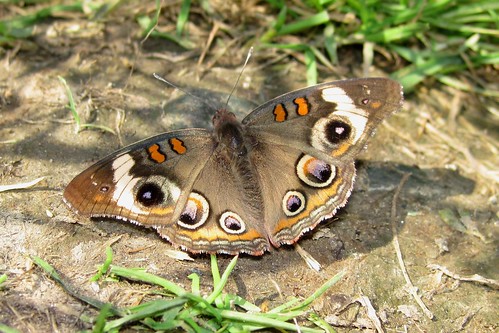
The Common Buckeye is a striking butterfly with bold eye spots that can be flaunted in an attempt to guise as an owl and intimidate potential predators. Just looking at the picture of this gorgeous insect, it isn't hard to believe that it would be exciting to see one at the North Branch Nature Center, but what makes this sighting special is that the Common Buckeye is amongst the rarest butterflies in Vermont.
The mostly tropical genus of Buckeyes are fairly common in the south, where they can be found year-round in some places. The Common Buckeye regularly wanders north in summers, colonizing new areas as it expands northwards, occasionally even penetrating into southern portions of New England, but is extremely rare as far north as Vermont. Colonization in New England is only temporary as this species cannot survive our harsh winters. In fact, no sightings were known in Vermont before 2004 and in the recently completed Vermont Butterfly Survey, it was one of the ten least frequently encountered butterfly species.
While it came as a surprise to find a Buckeye at the Nature Center, it wasn't totally unexpected. 2011 has been an unprecedented year for "southerners" in Vermont, with butterfly species such as Giant Swallowtails (extremely rare and only seen in southern Vermont), Harvesters, and also plenty of Common Buckeyes being reported from numerous locations around Vermont. In fact, on August 24, Bryan Pfeiffer found two Common Buckeyes near Wrightsville Reservoir, just down the road from NBNC.
As climate change progresses and our planet slowly warms, perhaps sightings like this will become more common. After all, while a warming planet will be detrimental to many species, for others, it will create new opportunities. As the graceful Buckeye suns itself on the trails at NBNC, it is somewhat bittersweet that we enjoy its vivid pattern as it flashes its "owl eyes" towards our gaze. While there are many ugly signs of our rapidly changing climate, some come with bright colors and wings.
Friday, September 16, 2011
Caterpillars of NBNC (part 2)
As we dig deep into our drawers, searching for sweatshirts forgotten months ago, it is hard not to wonder what caterpillars do to prepare as winter draws nearer. Some species of caterpillars are still active even into October. Here, we look at some more caterpillars found around the Nature Center and how they've adapted to make it through the long, cold winters:
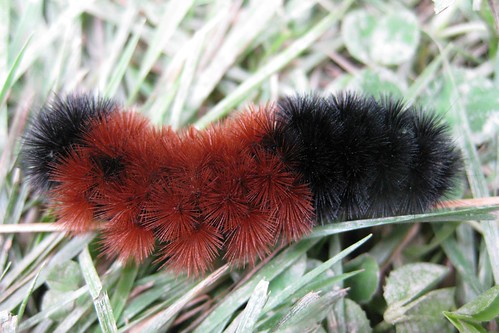
Its a sure sign that fall is around the corner when you see a Wooly Bear walking across the lawn. Wooly Bears, the larval name for the Isabella Tiger Moth, overwinter as caterpillars and pupate after emerging the next spring.
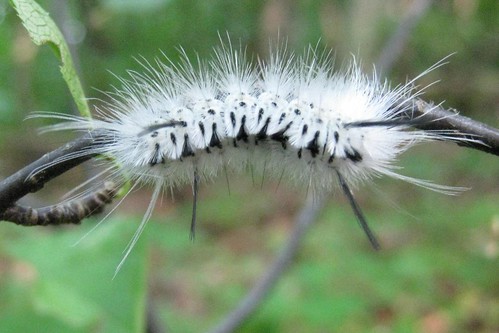
You can barely turn a corner around NBNC without bumping into a Hickory Tussock Moth caterpillar. They will stick together in groups when they first hatch in the mid-summer, but tend to separate as they grow, and by September can be fairly spread out. As winter comes, they will crawl into the leaf litter, spin a cocoon, and endure the cold months as a pupa.

These gentle giants start showing up in the fields of NBNC in late summer. The Gallium Sphinx Moth caterpillar feeds on bedstraw (aka Gallium). Caterpillars pupate and overwinter in loose cocoons in shallow underground burrows.
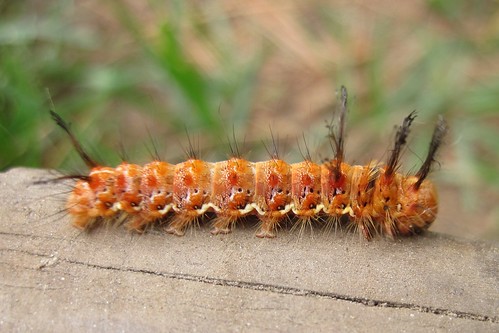
This caterpillar in the genus Panthea was found near the NBNC building this summer. Although we're not sure exactly what species it is, all in the genus feed exclusively on the needles of conifers and overwinter as pupae.
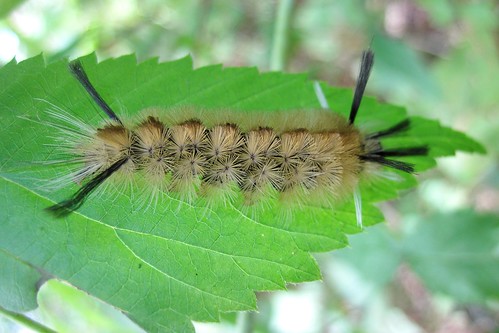
Many caterpillars, such as this Banded Tussock Moth, have tufts of hair protruding from various places. In fact, a "tussock" typically refers to a tuft of grass on a hummock, describing the hairy tufts. The Banded Tussock Moth incorporates many of its hairs into the cocoon where it overwinters.

Its a sure sign that fall is around the corner when you see a Wooly Bear walking across the lawn. Wooly Bears, the larval name for the Isabella Tiger Moth, overwinter as caterpillars and pupate after emerging the next spring.

You can barely turn a corner around NBNC without bumping into a Hickory Tussock Moth caterpillar. They will stick together in groups when they first hatch in the mid-summer, but tend to separate as they grow, and by September can be fairly spread out. As winter comes, they will crawl into the leaf litter, spin a cocoon, and endure the cold months as a pupa.

These gentle giants start showing up in the fields of NBNC in late summer. The Gallium Sphinx Moth caterpillar feeds on bedstraw (aka Gallium). Caterpillars pupate and overwinter in loose cocoons in shallow underground burrows.

This caterpillar in the genus Panthea was found near the NBNC building this summer. Although we're not sure exactly what species it is, all in the genus feed exclusively on the needles of conifers and overwinter as pupae.

Many caterpillars, such as this Banded Tussock Moth, have tufts of hair protruding from various places. In fact, a "tussock" typically refers to a tuft of grass on a hummock, describing the hairy tufts. The Banded Tussock Moth incorporates many of its hairs into the cocoon where it overwinters.
Tuesday, September 6, 2011
Caterpillars of NBNC (part 1)
Amongst the many creatures worth watching this fall, the caterpillars that creep and crawl around our fields and forests can be every bit as interesting as the moths and butterflies they become. Stunningly patterned and with fascinating behaviors, we've marveled at the variety of caterpillars we observe at NBNC every year. Here are a few that spent their larval-lives at the Center:
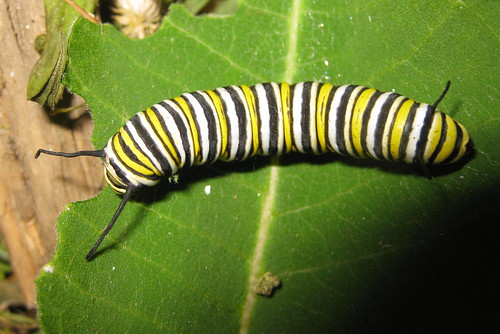
Monarch caterpillars feed on milkweed. The migratory Monarch butterfly makes a 2,000+ mile journey from Vermont to Mexico each fall. Join NBNC for Monarch tagging on Wednesday afternoons as we attempt to track their journey. More info about this program

Black Swallowtail caterpillar near the NBNC building at the edge of the field. Their host plants include those in the carrot family, such as Queen-Anne's-Lace, parsely, and dill.
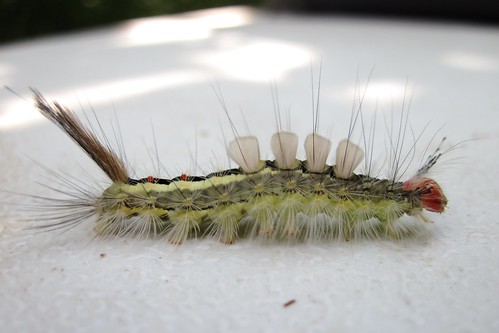
White-marked Tussock Moth. Caterpillars feed on a wide range of hardwoods and contain hairs(setae) that can cause skin irritation if handled.
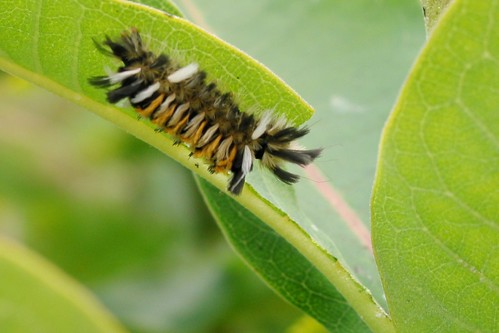
Milkweed Tussock Moth. To no surprise, caterpillars feed on milkweed. They can be gregarious, forming large groups.
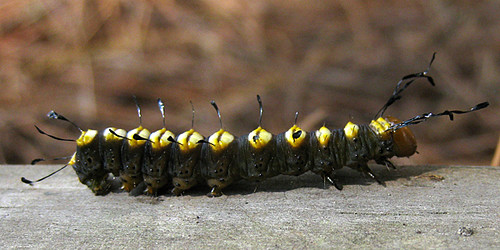
Paddle Caterpillar (Funerary Dagger Moth). A striking caterpillar whose long, paddle-shaped setae give it the resemblance of a viking ship. The caterpillar is described as "scarce" in Caterpillars of Eastern North America, but this individual was found right in the front lawn of NBNC!

Monarch caterpillars feed on milkweed. The migratory Monarch butterfly makes a 2,000+ mile journey from Vermont to Mexico each fall. Join NBNC for Monarch tagging on Wednesday afternoons as we attempt to track their journey. More info about this program

Black Swallowtail caterpillar near the NBNC building at the edge of the field. Their host plants include those in the carrot family, such as Queen-Anne's-Lace, parsely, and dill.

White-marked Tussock Moth. Caterpillars feed on a wide range of hardwoods and contain hairs(setae) that can cause skin irritation if handled.

Milkweed Tussock Moth. To no surprise, caterpillars feed on milkweed. They can be gregarious, forming large groups.

Paddle Caterpillar (Funerary Dagger Moth). A striking caterpillar whose long, paddle-shaped setae give it the resemblance of a viking ship. The caterpillar is described as "scarce" in Caterpillars of Eastern North America, but this individual was found right in the front lawn of NBNC!
Tuesday, July 19, 2011
Fern Fanatics: Why You Should Love Ferns
They’re lush. They’re soft. They can carpet the forest floor. Whether you’re in swamp, field, or on rocky ledge, they are there. Ferns add a vibrant texture to our landscape, and when we begin to look more closely at them, there is a lot to discover.

Ferns occupy a unique niche amongst the plants of our world. Unlike many of our plants that reproduce by flower and seed, ferns are derived from a more primitive lineage that, like mushrooms, use spores to spread and multiply (although like some flowering plants, they can also spread underground via rhizomes). Flip over the frond of a fern (the leaf-like blades that protrude from the ground) and you may discover the ferns’ sori, or “spore packets”.
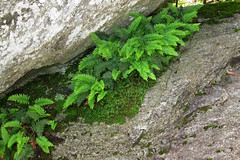 While we often think of ferns as occupants of dark, dank forests, many types can thrive in almost every crack and crevice of Vermont. Royal Fern may line the edges of lakes and ponds, while Common Polypody clings to the rocky surfaces of boulders and cliffs. While some are easy to identify, like the elegant Maidenhair Fern which grows in limestone soils of rich, moist forests, others can present quite a challenge to tell apart.
While we often think of ferns as occupants of dark, dank forests, many types can thrive in almost every crack and crevice of Vermont. Royal Fern may line the edges of lakes and ponds, while Common Polypody clings to the rocky surfaces of boulders and cliffs. While some are easy to identify, like the elegant Maidenhair Fern which grows in limestone soils of rich, moist forests, others can present quite a challenge to tell apart.
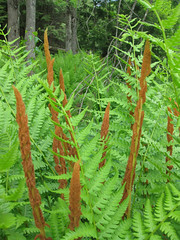 Flex your fern skills and join us for a woodland walk in Middlesex Notch with former botany professor Murray Evans. This will be a leisurely walk to explore some unusual species including Silvery Glade Fern and Maidenhair Spleenwort. No experience is necessary, and we hope you’ll take this opportunity to revisit some familiar ferns or explore a whole new facet of the natural world. This event takes place Please call 229-6206 with any questions and to register.
Flex your fern skills and join us for a woodland walk in Middlesex Notch with former botany professor Murray Evans. This will be a leisurely walk to explore some unusual species including Silvery Glade Fern and Maidenhair Spleenwort. No experience is necessary, and we hope you’ll take this opportunity to revisit some familiar ferns or explore a whole new facet of the natural world. This event takes place Please call 229-6206 with any questions and to register.
Bonus Question: Can you identify the fern photos in this blog post? Below are some resources to help get you started:
Winooski Valley Park District Fern Guide
Common Ferns of Vermont

Ferns occupy a unique niche amongst the plants of our world. Unlike many of our plants that reproduce by flower and seed, ferns are derived from a more primitive lineage that, like mushrooms, use spores to spread and multiply (although like some flowering plants, they can also spread underground via rhizomes). Flip over the frond of a fern (the leaf-like blades that protrude from the ground) and you may discover the ferns’ sori, or “spore packets”.
 While we often think of ferns as occupants of dark, dank forests, many types can thrive in almost every crack and crevice of Vermont. Royal Fern may line the edges of lakes and ponds, while Common Polypody clings to the rocky surfaces of boulders and cliffs. While some are easy to identify, like the elegant Maidenhair Fern which grows in limestone soils of rich, moist forests, others can present quite a challenge to tell apart.
While we often think of ferns as occupants of dark, dank forests, many types can thrive in almost every crack and crevice of Vermont. Royal Fern may line the edges of lakes and ponds, while Common Polypody clings to the rocky surfaces of boulders and cliffs. While some are easy to identify, like the elegant Maidenhair Fern which grows in limestone soils of rich, moist forests, others can present quite a challenge to tell apart. Flex your fern skills and join us for a woodland walk in Middlesex Notch with former botany professor Murray Evans. This will be a leisurely walk to explore some unusual species including Silvery Glade Fern and Maidenhair Spleenwort. No experience is necessary, and we hope you’ll take this opportunity to revisit some familiar ferns or explore a whole new facet of the natural world. This event takes place Please call 229-6206 with any questions and to register.
Flex your fern skills and join us for a woodland walk in Middlesex Notch with former botany professor Murray Evans. This will be a leisurely walk to explore some unusual species including Silvery Glade Fern and Maidenhair Spleenwort. No experience is necessary, and we hope you’ll take this opportunity to revisit some familiar ferns or explore a whole new facet of the natural world. This event takes place Please call 229-6206 with any questions and to register.Bonus Question: Can you identify the fern photos in this blog post? Below are some resources to help get you started:
Winooski Valley Park District Fern Guide
Common Ferns of Vermont
Friday, July 1, 2011
What to Do if you Find a Baby Bird
Every summer, we receive numerous phone calls at NBNC from people who have found baby birds out of their nests, wondering what they can do to help. Not only is info on baby birds often lacking, but there is a lot of misinformation with regards to the proper course of action.
It is a natural part of most songbirds' development for them to spend some time out of the nest before they are capable of full flight. During this time, they are often still cared for by their parents (who are often watching from a bush or tree where you can't see them). If the bird is fully feathered, it is likely at this stage in its life and no intervention should be necessary, aside from keeping dogs and cats away.
If the bird is not feathered, returning it to its nest may be the best option, so look up and see if you can find/reach the nest. Contrary to popular belief, baby birds will not be rejected by their parents if handled by humans. It can be very difficult to tell if a baby bird was abandoned as parents will often stay away if they see you nearby, and go through every effort not to draw attention to their young. If you know for sure that the bird is abandoned (ie, mom was eaten by the neighbor's cat) you should find a trained wildlife rehabilitater, as baby birds require specialized care. You can contact the Nature Center for this info.
This short post gives a brief introduction to a few of the different scenarios that can unfold when a baby bird is found, but should you need further advice, please see the additional resources provided below: Mass Audubon
It is a natural part of most songbirds' development for them to spend some time out of the nest before they are capable of full flight. During this time, they are often still cared for by their parents (who are often watching from a bush or tree where you can't see them). If the bird is fully feathered, it is likely at this stage in its life and no intervention should be necessary, aside from keeping dogs and cats away.
If the bird is not feathered, returning it to its nest may be the best option, so look up and see if you can find/reach the nest. Contrary to popular belief, baby birds will not be rejected by their parents if handled by humans. It can be very difficult to tell if a baby bird was abandoned as parents will often stay away if they see you nearby, and go through every effort not to draw attention to their young. If you know for sure that the bird is abandoned (ie, mom was eaten by the neighbor's cat) you should find a trained wildlife rehabilitater, as baby birds require specialized care. You can contact the Nature Center for this info.
This short post gives a brief introduction to a few of the different scenarios that can unfold when a baby bird is found, but should you need further advice, please see the additional resources provided below: Mass Audubon
Saturday, June 25, 2011
Robin Rescued from Tangled Fishing Line
While out for a short visit to a local birding spot on the Winooski River this evening I got way more than I bargained for. As I descended the steep trail towards the river and a nearby marsh, I heard the distress calls of a Robin, and as I reached the sandy shore and rounded a corner, I saw a female Robin with its foot entangled in a big ball of fishing line.
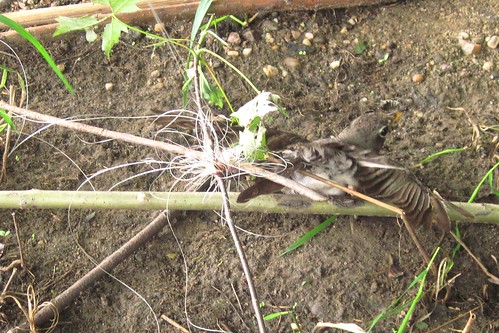
Having experience working at bird banding stations, most recently at North Branch Nature Center, I felt confident that I could remedy the situation. Over the next 45 minutes, I worked to free her, first by restraining the bird using the “bander’s grip” and trying to tear the line. The line proved too tough to tear by hand; in fact, it tore my hand a bit! Without a way to break the line, I had to bring the line, bird, and all, back up to the parking area. There was line everywhere, wrapped up in trees, bushes, and sticks, and it was difficult to gather with one hand, and without putting tension on the line that could injure the bird. When I finally got all the line, I carried it (and the bird) back up the bank to the parking area.

I didn't have anything to cut the line in my car, so I knocked on the door of the nearest house. The homeowner came to the rescue with some small scissors, and I was eventually able to free the bird and release it unharmed. Her foot was wrapped tight, looking as if she had twisted and turned in the time after she became stuck and before I arrived. During the whole incident, a gang of Robins were crowded around us, squawking like mad. Upon her release, she flew a short distance and landed in the middle of the road. Shortly thereafter, a male landed next to her as if to console her. He stayed by her side, occasionally hopping, for several minutes while she sat still, and then they both flew off together.
Thankfully, this story had a happy ending, but the truth is that many animals get injured or killed by discarded fishing line, netting, plastic, and other litter. We should all not only take the responsibility to clean up after ourselves, but we should do our best to remove litter whenever we see it… if we do, we might just save a bird’s life.
Check back for pictures of the bird upon her release… they are being sent by the homeowner and will be posted to the blog shortly.

Having experience working at bird banding stations, most recently at North Branch Nature Center, I felt confident that I could remedy the situation. Over the next 45 minutes, I worked to free her, first by restraining the bird using the “bander’s grip” and trying to tear the line. The line proved too tough to tear by hand; in fact, it tore my hand a bit! Without a way to break the line, I had to bring the line, bird, and all, back up to the parking area. There was line everywhere, wrapped up in trees, bushes, and sticks, and it was difficult to gather with one hand, and without putting tension on the line that could injure the bird. When I finally got all the line, I carried it (and the bird) back up the bank to the parking area.

I didn't have anything to cut the line in my car, so I knocked on the door of the nearest house. The homeowner came to the rescue with some small scissors, and I was eventually able to free the bird and release it unharmed. Her foot was wrapped tight, looking as if she had twisted and turned in the time after she became stuck and before I arrived. During the whole incident, a gang of Robins were crowded around us, squawking like mad. Upon her release, she flew a short distance and landed in the middle of the road. Shortly thereafter, a male landed next to her as if to console her. He stayed by her side, occasionally hopping, for several minutes while she sat still, and then they both flew off together.
Thankfully, this story had a happy ending, but the truth is that many animals get injured or killed by discarded fishing line, netting, plastic, and other litter. We should all not only take the responsibility to clean up after ourselves, but we should do our best to remove litter whenever we see it… if we do, we might just save a bird’s life.
Check back for pictures of the bird upon her release… they are being sent by the homeowner and will be posted to the blog shortly.
Sunday, June 12, 2011
Turtle Tutorial
Within central Vermont, our most common turtles, the Painted and Snapping Turtles, spend the majority of their time in close proximity to water, rarely more than a few feet from it. Much of their lives are hidden from view, below the surface of our rivers, lakes and ponds. It is during the most important and vulnerable time in their lives when they venture to our world on dry land.
During these late-spring/early-summer months, Painted and Snapping Turtles leave the water in search of a place to lay their eggs. They favor open, sunny areas with loose, sandy soils to dig their nests. This preference often proves to their detriment, as roadsides, trails, and gardens often meet the turtles’ needs and cause them to come into conflict with people. Most turtles typically don’t travel far, but a female snapper is willing to travel over a half-mile in order to find a suitable nesting site.
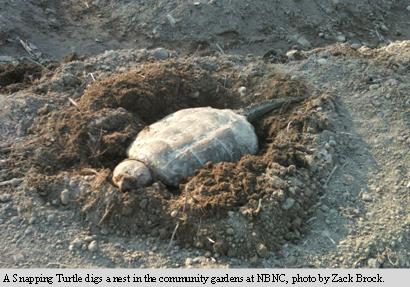
If you come across a turtle, it is not advisable to relocate it to your favorite neighborhood pond down the road. What you can do is search for evidence of whether or not she has laid eggs (is she walking towards the water? away? Is she digging a hole? filling one?). If you’ve found evidence that she has already laid eggs, you can try bringing her back to the nearby wetland where she came from. If you don’t find any evidence that she has laid eggs, moving her will do little good as her instincts will drive her back to land to nest.
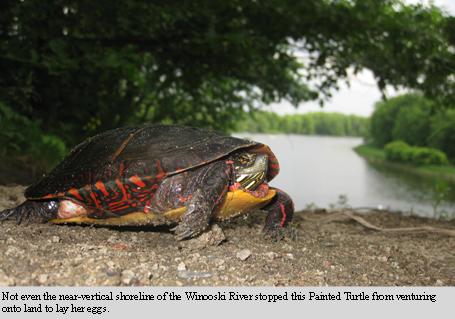
Moving Painted Turtles is fairly straightforward. Most will recoil as far into their shell as they can squeeze, but occasionally one may struggle and scratch at you with its claws. Rarely is any real damage inflicted. Snapping Turtles, however, live up to their namesake. In water they are quite docile, but on land their aggression is unmatched. Their powerful beak can clamp down with great force and speed, and their long necks give them a surprisingly long reach. There is no easy way to move a large snapper.
 Carefully moving the turtle with a shovel may save you having to touch it, but if such a tool is unavailable, here are some other tips. Immobilizing the turtle by covering its head with a towel or other cloth may restrict its ability to snap at you. Never carry a turtle by the tail as it can cause injury. Instead, grab her with a hand on each side of her carapace (top shell) just above her hind legs. Be careful, as her neck is long and can snap backwards a considerable distance. Also beware that her claws are long and sharp, and without protective handware, she can easily draw blood.
Carefully moving the turtle with a shovel may save you having to touch it, but if such a tool is unavailable, here are some other tips. Immobilizing the turtle by covering its head with a towel or other cloth may restrict its ability to snap at you. Never carry a turtle by the tail as it can cause injury. Instead, grab her with a hand on each side of her carapace (top shell) just above her hind legs. Be careful, as her neck is long and can snap backwards a considerable distance. Also beware that her claws are long and sharp, and without protective handware, she can easily draw blood.
When the turtle you encounter on land lays her eggs, you might find the location she has picked is not conducive to a successful breeding season. For example, the pile of woodchips next to the street tree nursery at NBNC was not a wise place for a female snapper in 2009. Her eggs would have dried up quickly in the woodchips and the pile would not have remained in that place throughout the summer. Ultimately, we decided the only way to prevent her nest from failing was to relocate the eggs.
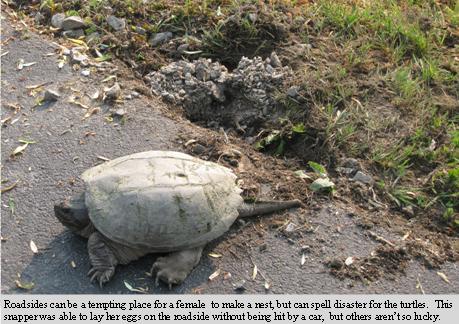
Under the extreme circumstance that a nest needs relocation, look for a spot with good sun exposure, similar soil moisture (not too dry, not saturated), and bury the eggs at a similar depth. Some people believe it is best to keep the eggs the same side up while others are not convinced that it matters. Bare soil or just grass cover is good, but anything that will grow deep roots and provide shade is a bad idea.
Once a female has successfully laid her eggs, her role in their lives has ended. The threats the hatchlings will face are numerous, and they will have no parental supervision… just instinct. When discovered by raccoons, nests are quickly exhumed and eaten. Nests near human habitation are especially susceptible to this predation, as raccoons occur in greater densities in highly human-populated areas. If they are lucky enough to make it through the summer, a clutch of tiny, quarter-sized hatchlings will emerge from the soil in late fall, or early the next spring. In their first days, their shells are soft and malleable, offering little protection from predators. Some of the many creatures that could consume a baby turtle include crows, bullfrogs, bass, raccoons, otters, snakes, and countless others.
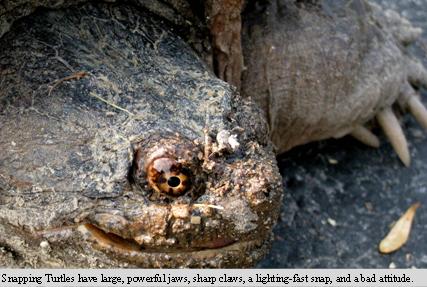
Next time you are out driving the streets, hiking the trails, or tending to the garden, and a turtle comes into view, don’t panic! Instead, enjoy the miraculous feat of nature at hand. Assess the situation and take action if warranted. Take some pictures and submit your sighting to the Vermont Reptile & Amphibian Atlas. And share your story with us, we’d love to hear about your turtle experience!
During these late-spring/early-summer months, Painted and Snapping Turtles leave the water in search of a place to lay their eggs. They favor open, sunny areas with loose, sandy soils to dig their nests. This preference often proves to their detriment, as roadsides, trails, and gardens often meet the turtles’ needs and cause them to come into conflict with people. Most turtles typically don’t travel far, but a female snapper is willing to travel over a half-mile in order to find a suitable nesting site.

If you come across a turtle, it is not advisable to relocate it to your favorite neighborhood pond down the road. What you can do is search for evidence of whether or not she has laid eggs (is she walking towards the water? away? Is she digging a hole? filling one?). If you’ve found evidence that she has already laid eggs, you can try bringing her back to the nearby wetland where she came from. If you don’t find any evidence that she has laid eggs, moving her will do little good as her instincts will drive her back to land to nest.

Moving Painted Turtles is fairly straightforward. Most will recoil as far into their shell as they can squeeze, but occasionally one may struggle and scratch at you with its claws. Rarely is any real damage inflicted. Snapping Turtles, however, live up to their namesake. In water they are quite docile, but on land their aggression is unmatched. Their powerful beak can clamp down with great force and speed, and their long necks give them a surprisingly long reach. There is no easy way to move a large snapper.
 Carefully moving the turtle with a shovel may save you having to touch it, but if such a tool is unavailable, here are some other tips. Immobilizing the turtle by covering its head with a towel or other cloth may restrict its ability to snap at you. Never carry a turtle by the tail as it can cause injury. Instead, grab her with a hand on each side of her carapace (top shell) just above her hind legs. Be careful, as her neck is long and can snap backwards a considerable distance. Also beware that her claws are long and sharp, and without protective handware, she can easily draw blood.
Carefully moving the turtle with a shovel may save you having to touch it, but if such a tool is unavailable, here are some other tips. Immobilizing the turtle by covering its head with a towel or other cloth may restrict its ability to snap at you. Never carry a turtle by the tail as it can cause injury. Instead, grab her with a hand on each side of her carapace (top shell) just above her hind legs. Be careful, as her neck is long and can snap backwards a considerable distance. Also beware that her claws are long and sharp, and without protective handware, she can easily draw blood.When the turtle you encounter on land lays her eggs, you might find the location she has picked is not conducive to a successful breeding season. For example, the pile of woodchips next to the street tree nursery at NBNC was not a wise place for a female snapper in 2009. Her eggs would have dried up quickly in the woodchips and the pile would not have remained in that place throughout the summer. Ultimately, we decided the only way to prevent her nest from failing was to relocate the eggs.

Under the extreme circumstance that a nest needs relocation, look for a spot with good sun exposure, similar soil moisture (not too dry, not saturated), and bury the eggs at a similar depth. Some people believe it is best to keep the eggs the same side up while others are not convinced that it matters. Bare soil or just grass cover is good, but anything that will grow deep roots and provide shade is a bad idea.
Once a female has successfully laid her eggs, her role in their lives has ended. The threats the hatchlings will face are numerous, and they will have no parental supervision… just instinct. When discovered by raccoons, nests are quickly exhumed and eaten. Nests near human habitation are especially susceptible to this predation, as raccoons occur in greater densities in highly human-populated areas. If they are lucky enough to make it through the summer, a clutch of tiny, quarter-sized hatchlings will emerge from the soil in late fall, or early the next spring. In their first days, their shells are soft and malleable, offering little protection from predators. Some of the many creatures that could consume a baby turtle include crows, bullfrogs, bass, raccoons, otters, snakes, and countless others.

Next time you are out driving the streets, hiking the trails, or tending to the garden, and a turtle comes into view, don’t panic! Instead, enjoy the miraculous feat of nature at hand. Assess the situation and take action if warranted. Take some pictures and submit your sighting to the Vermont Reptile & Amphibian Atlas. And share your story with us, we’d love to hear about your turtle experience!
Monday, June 6, 2011
Birding Quest: 6-month Update
As you may have heard, NBNC has been rallying both avid and beginning birdwatchers throughout Washington County to participate in a state-wide bird “quest”. All fourteen Vermont counties are striving to document as many types of birds as possible using the free, online database called eBird. Half way through the year, Washington County birders have a lot to be proud of. As of June 1, 167 species have been observed in the county (compared with 149 species last year). Of particular note so far in 2011 has been the abundance of shorebirds and waterfowl that passed through county, many of which are listed below in the “notable sightings”. With another six months left, there is no telling what surprises might be in store… Visit the Washington County Birding Challenge page for updates.
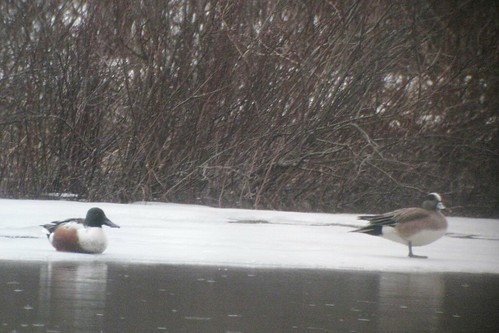
The Shoveler (left) and Wigeon (right) stood side-by-side on Berlin Pond this spring, not knowing how rare they are in Washington County!
Notable Sightings (based on current records in eBird)
1st Documented Sighting:
Semipalmated Plover
2nd Documented Sighting:
Surf Scoter (first sighting in over 30 years!)
Sora (first sighting in over 30 years!)
Lesser Yellowlegs
Great Black-backed Gull
Northern Hawk Owl
3rd Documented Sighting:
American Wigeon (also 4th sighting)
Northern Shoveler (also 4th sighting)
Great Egret

The Shoveler (left) and Wigeon (right) stood side-by-side on Berlin Pond this spring, not knowing how rare they are in Washington County!
Notable Sightings (based on current records in eBird)
1st Documented Sighting:
Semipalmated Plover
2nd Documented Sighting:
Surf Scoter (first sighting in over 30 years!)
Sora (first sighting in over 30 years!)
Lesser Yellowlegs
Great Black-backed Gull
Northern Hawk Owl
3rd Documented Sighting:
American Wigeon (also 4th sighting)
Northern Shoveler (also 4th sighting)
Great Egret
Monday, May 16, 2011
Binoculars + Caffeine + New Jersey = World Series of Birding
Another year; another great trip for New Jersey for the World Series… a 24-hour birding marathon in which 80 teams scoured the garden state for every bird species they could find. Although we didn’t see the bird/creature on the right, it was the emblem for our team “The Chocolate-headed Cowbirds (with sprinkles)” which celebrates the support we received from a grant made by Ben & Jerry’s. Whether we were scouring the 10,000+ shorebirds at Heislerville, peering through the canopy to see the Acadian Flycatcher at Belleplain, or whistling to Eastern Screech-Owls just before dawn, our mixed-aged team enjoyed every minute of the trip.
Weather has played a major role in what birds we see during the competition and this year was no different. Migrating warblers were wholly absent and raptors were sparse. We often needed to visit 2-3 locations to find particular birds species that were found easily the day before. While some birds proved very difficult to find, we had great luck with sea birds. Amongst the ocean-faring birds we saw were Common Loon, Northern Gannet, Black Scoter, Surf Scoter, and a total of 3 Parasitic Jaegers! Another highlight was the huge abundance of shorebirds at Heislerville. While we missed the rare Curlew Sandpiper that hid amongst the thousands of shorebirds, we did manage to find 18 species of shorebirds during the big day including a banded Semipalmated Sandpiper (pictured right).
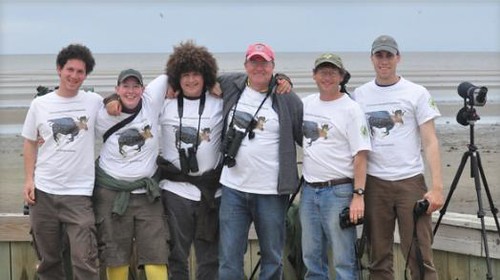
(our group during the big day... about 13 hours into our birding adventure)
The Northern Flicker that flew over the van on our trip back raised our total species count for the trip to 150, with 139 species seen during the competition. A complete list of birds seen during our big day is shown below:
(click on the checklist to see a bigger version)

Friday, May 6, 2011
Day of the Nighthawk
The North Branch Nature Center’s Youth Birding Program has partnered with middle school students in central Vermont to revitalize the nesting habitat of the Common Nighthawk. Once a common sight to people in Vermont cities, nighthawks used to swoop and dive across the sky at dusk, collecting insects as they went. Their preference to nest in large, open spaces may once have precluded Vermont from possible breeding locations, but since at least the late 1800’s Common Nighthawks have made use of gravel rooftops to raise their young.

Unfortunately, the Common Nighthawk is in steep decline throughout its breeding range and has not been seen breeding in Montpelier in recent years. One cause of their decline is loss of habitat: both natural and artificial. Conversion of gravel rooftops to other substrates is believed to be one cause for their disappearance from urban areas. In 2007, New Hampshire Audubon began a research initiative to install gravel “nest patches” on rooftops in order to create the Nighthawk’s preferred gravel nesting sites. Students from U-32 Middle/High School (Montpelier) and Crossett Brook Middle School (Waterbury), in partnership with North Branch Nature Center, will replicate the efforts of NH Audubon by installing Vermont’s first nest patches.
Yesterday, U-32 students installed a nest patch on their school’s roof, and will monitor this patch over the next few weeks. As Nighthawks return from their winter in South America and establish nesting sites in New England, we’ll be watching to see if our nest patch is used by a lucky Nighthawk family. Photos from the installation will be coming soon...

Unfortunately, the Common Nighthawk is in steep decline throughout its breeding range and has not been seen breeding in Montpelier in recent years. One cause of their decline is loss of habitat: both natural and artificial. Conversion of gravel rooftops to other substrates is believed to be one cause for their disappearance from urban areas. In 2007, New Hampshire Audubon began a research initiative to install gravel “nest patches” on rooftops in order to create the Nighthawk’s preferred gravel nesting sites. Students from U-32 Middle/High School (Montpelier) and Crossett Brook Middle School (Waterbury), in partnership with North Branch Nature Center, will replicate the efforts of NH Audubon by installing Vermont’s first nest patches.
Yesterday, U-32 students installed a nest patch on their school’s roof, and will monitor this patch over the next few weeks. As Nighthawks return from their winter in South America and establish nesting sites in New England, we’ll be watching to see if our nest patch is used by a lucky Nighthawk family. Photos from the installation will be coming soon...
Tuesday, April 26, 2011
Central Vermont's Big Night
After numerous photo-reports from around the state, Central Vermont has been very patient in waiting for our amphibians to finally awake and emerge. Last night they did just that, and in record numbers! Reports are still coming in, but widespread movements were reported from around central Vermont (and elsewhere). Weather looks good again tonight, so watch the roads if you must be out-and-about! Enjoy the following video and photos from crossing sites in Middlesex:
A "congress" of salamanders!
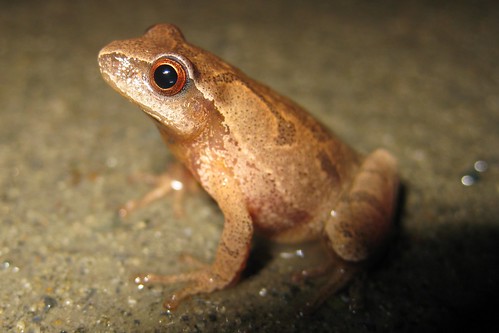
Spring Peeper
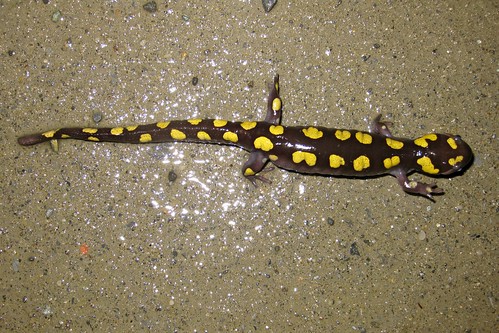
Spotted Salamander
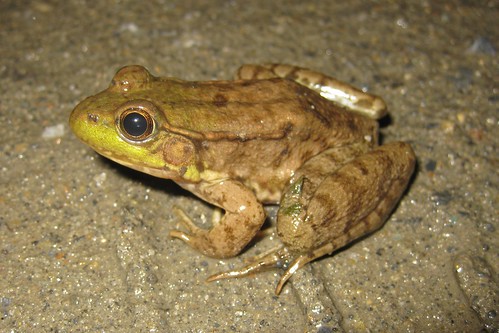
Green Frog

Eastern Newt

American Toad
A "congress" of salamanders!

Spring Peeper

Spotted Salamander

Green Frog

Eastern Newt

American Toad
Monday, April 25, 2011
Woodland Wildflowers
For a narrow window of time each spring, our forests erupt in an explosion of color as the woodland wildflowers bloom. Many of these flowers are in a race to leaf out and blossom before the tree canopy above closes, blocking sunlight from reaching the forest floor. Our earliest wildflowers are just starting to pop up in Central Vermont (Blood Root is flowering along the river at NBNC) and many more are on the way! For all those who enjoy spring flowers and would like to take their interest a step further, researchers are recruiting citizen scientists to help study the pollinators of Spring Beauty, a lovely little wildflower found around Vermont.
Enjoy this assortment of photos from the Greater-Burlington area, all taken this past weekend (April 23/24):

Dutchman's Breeches

Coltsfoot

Marsh Marigold

Trout Lily
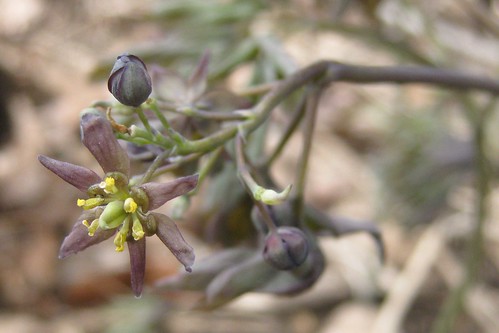
Blue Cohosh
Enjoy this assortment of photos from the Greater-Burlington area, all taken this past weekend (April 23/24):

Dutchman's Breeches

Coltsfoot

Marsh Marigold

Trout Lily

Blue Cohosh
Subscribe to:
Posts (Atom)



